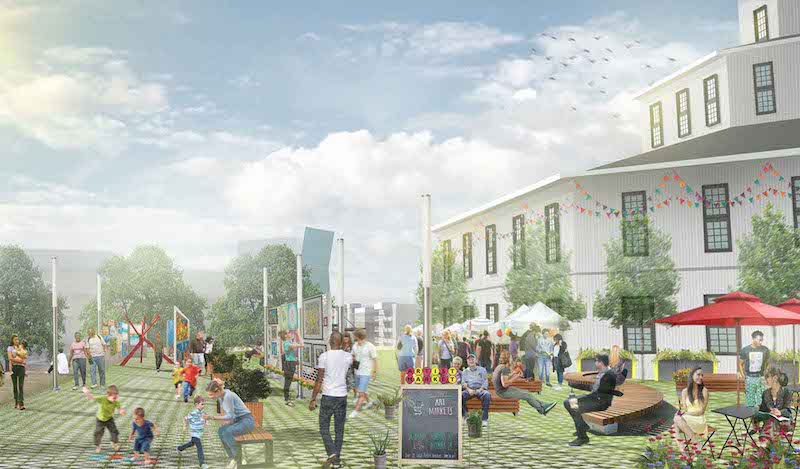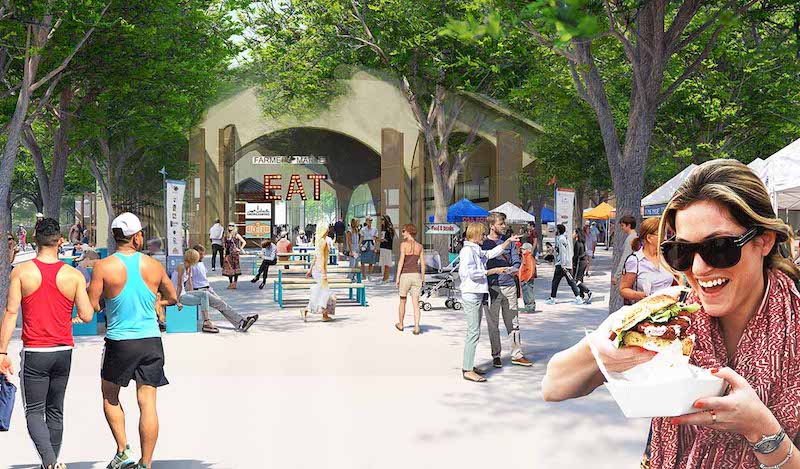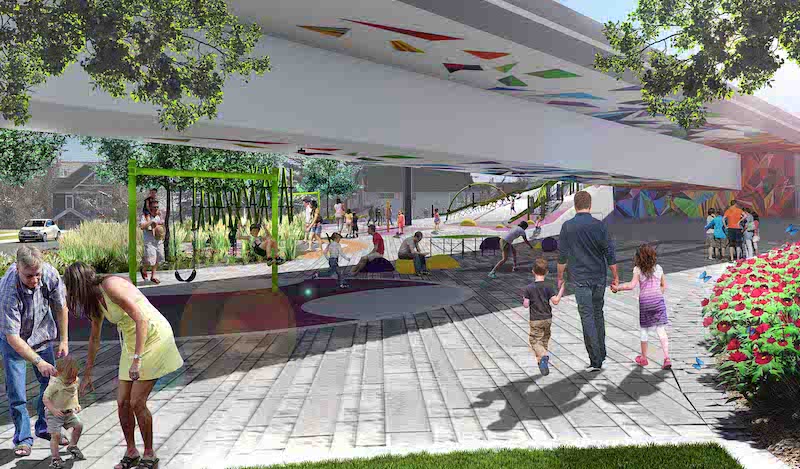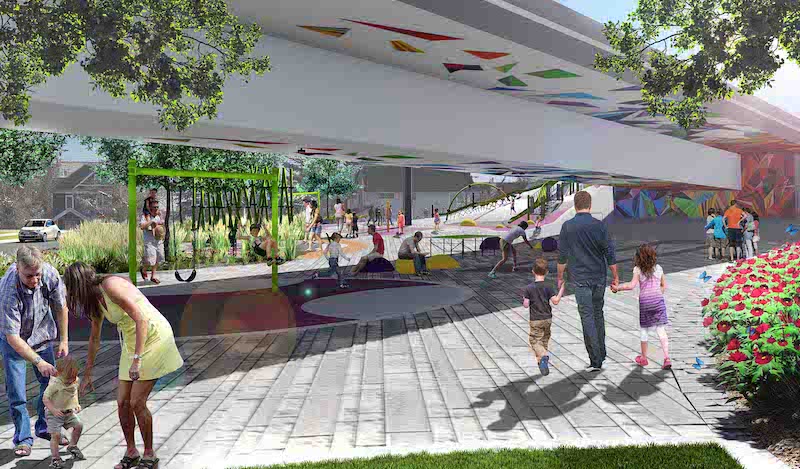One of the major global trends that we’ve seen during the last 50 years has been the steady shift of populations from rural communities to urban areas. Globally, people are flocking from the countryside to city centers. In fact, the United Nations estimates that more than two thirds of the world’s population will live in urban areas by 2050.
We know the primary cause of this trend: Cities tend to offer more economic, social, and political liberties than rural areas. But what are the results? A process of rapid urban development, for one. The more people, the more urban infrastructure is needed to support the day-to-day life of city dwellers. And in North America, more than 82% of people live in urban areas—a number that is only on the rise.
As we continue to build up our cities, we are realizing the significance of urban open spaces. Open space (comprised of both green space and gray space) is one of the most important elements in making a downtown city center feel more like an urban community. So, when we’re planning a park for a downtown population, we always design with a strategic open space in mind. We’ve worked on several urban park projects around North America. We’ve seen what works—and what doesn’t. Following are five keys to successfully planning and programming your urban community open space projects.
 Open space is one of the most important elements in making a downtown city center feel more like an urban community. (Roundhouse Plaza, Dayton Ohio).
Open space is one of the most important elements in making a downtown city center feel more like an urban community. (Roundhouse Plaza, Dayton Ohio).
1. Is your open space telling a story? If so, what is it?
Some people call it placemaking. Others call it theming or branding. But what do these approaches to designing open spaces have in common? They focus on telling a story that resonates with communities and ties them into an urban center with a unique identity. A good story can create connections between a site and its users by tapping into shared experiences, common values, or the excitement of experiencing something new.
In the context of mapping out urban places and designing spaces that speak to the users, the story can take on many forms:
— Historical: These types of stories are based on the real history of a site, or even an “embellished” history. A nod to history can ground people in the area, as well as preserve or establish local tradition and heritage.
— Playful: Recreational, whimsical stories that rely on active play to increase joy and enhance creativity. Playful spaces can positively affect health.
— Inspirational: Providing a connection to the site or a surrounding context, these stories—told through project design—influence a user by evoking internal feelings of beauty, creativity, or astonishment. Stories inspire when a project makes a user feel something.
— Imaginative: These stories elicit an intangible yet real feeling that can transcend the worries of everyday life and transport users to their own “happy place.” Using site clues, designs, or amenities, open spaces can spur imagination, triggering thoughts and images that are not actually present.
— Emotional: These stories help a space bring out our thoughts, feelings, and experiences in reaction to what is being viewed. A memorial is a good example of an emotional story.
2. Strong community engagement is a must
Before you even begin planning an urban open space, it is critical that you consult with the surrounding community. Every city has different wants and needs. Every city has its own set of conditions and challenges. That’s why a new urban space requires a robust community engagement process prior to planning—you need to get into the heads and hearts of the people you’re designing for. What is the current situation downtown? What does the city hope to achieve? What do people need that they don’t have? What do people have that they don’t need?
A thorough community engagement process allows you to better understand the community you are planning for. Landscape architecture for urban spaces must understand an increasing number of profound social and environmental issues and embrace their complexity in new and exciting ways. So, how can you ensure that you’re planning the right park project for a community? Try pursuing the following engagement techniques:
— Hold focus groups to understand the unfettered needs of community members
— Show examples of what has worked—and what hasn’t—in other cities
— Provide an assortment of concept designs to gauge interest in programming
— Identify cities with similar conditions and demonstrate how different ideas worked there
— Get creative! Oftentimes, people won’t know what’s possible until you show them.
When our landscape architecture team was asked to design the Albany Skyway in New York, we knew that it was going to be a unique urban corridor development. It’s not every day we get to convert an elevated interstate ramp into an ADA-compliant linear park, but the community needed to find a productive use for the overbuilt infrastructure. The Albany Skyway will provide a gorgeous urban open space that offers greater connectivity and mobility—plus our design won an ACEC Diamond Award and the ASLA New York Award of Merit.
 Designing a new urban space requires a robust community engagement process prior to planning—you need to get into the heads and hearts of the people you’re designing for. (Albany Skyway, New York).
Designing a new urban space requires a robust community engagement process prior to planning—you need to get into the heads and hearts of the people you’re designing for. (Albany Skyway, New York).
3. Design spaces that are part of something bigger
When designing an urban site, it is important to consider its surroundings. Understanding the context of the site allows a design to tie into larger systems. When new spaces neglect the bigger picture, they are unlikely to draw users or blend in with the surroundings. Here’s how you can make sure you are designing a space that does well within the larger context of the community:
— Understand how the surrounding spaces and the project site are currently used. This is essential to creating a space that positively impacts a community past the site boundaries.
— Ensure a design can be communicated to non-designers. This helps you gather useful feedback from the actual users of the site.
— Don’t let your design be defined by project boundaries. Look outward at a surrounding context and seek opportunities to build connections—both physical and implied.
— Make every effort to promote connectivity between your space and the adjacent shops, cafés, and restaurants. This way, people are more likely to stay longer. And who knows, maybe they’ll even take their coffee for a stroll in the park!
The Old Sacramento Waterfront is a good example of an open space that ties into the larger community. When the City of Sacramento, California, wanted to re-envision their waterfront, they asked us to design an iconic riverfront destination that could act as the front yard for the City. Not only would our design connect visitors with nature but it would also bring life to the nearby streetscape. Hotels, restaurants, mixed-use retail shops, parks, and playgrounds—one of the main goals of the Old Sacramento Waterfront was to bring people of all ages, backgrounds, and life experiences together in one vibrant, cultural, and welcoming location.
 The Old Sacramento Waterfront is envisioned to include seasonal markets and a vibrant activity calendar. (Old Sacramento Waterfront, California).
The Old Sacramento Waterfront is envisioned to include seasonal markets and a vibrant activity calendar. (Old Sacramento Waterfront, California).
4. Strategize your streetscape
We now know that a key aspect of urban park planning is detailing how your design will integrate with the rest of the neighborhood. Is there a strong connectivity to the surrounding infrastructure? How will the adjacent streets impact your design? Is your design accessible for all? These are all questions that must be addressed for a successful result. That’s why our team believes in strategizing the streetscapes.
What do we mean when we say that? Well, there are several routes we take to maximize the effectiveness of our design. Here are a few that could work for you:
— Engage in efforts to lessen impacts from passing vehicular traffic. This includes everything from minimizing noise to maximizing safety for our children.
— Provide multimodal options for transportation, such as bike lanes, parking spaces, or walking paths.
— Stress accessibility! The more people that can access your park, the more people that will use it. This includes everything from installing easy drop-off zones for persons with disabilities to thoughtful design elements for our seniors.
— Create enhanced connectivity between the space and surrounding circulation routes. Your design should make people want to go slightly out of their way to experience the space, so aim for easy connections and multiple ways to get in and out.
The City of Calgary is in the process of redesigning and updating several of the City’s main streets—one of those is Marda Loop. Our designs have been focused on increasing the activation of the streetscape, creating flexible spaces for programming and events, and ensuring the safety of all area users.
 The Marda Loop project is reenvisioning the public realm in Calgary, all while creating a multimodal street cross section that is flexible in use and open to the adjacent businesses to extend into the public realm. (Marda Loop, Calgary).
The Marda Loop project is reenvisioning the public realm in Calgary, all while creating a multimodal street cross section that is flexible in use and open to the adjacent businesses to extend into the public realm. (Marda Loop, Calgary).
5. Programming: One size does not fit all
Great outdoor urban spaces shouldn’t be developed using a cookie-cutter approach. Our work relies deeply on community dialogue. If your design can’t create a strong relationship between people and the park, then you shouldn’t expect them to use it.
The importance of community engagement cannot be stressed enough. You need to find out what your targeted users need before you offer up design concepts. For instance, one community may need flexible space for events, concerts, and community markets, while another may require a more passive, naturalistic respite. While the specifics may change from one urban space to another, there are five things you can do to enhance the programming options of your design:
- — Design for flexibility: While specific programming will be necessary, designing flexible use into urban spaces is key to success. These can be vibrant plaza spaces for café dining and food markets, or open spaces for recreation, events, or getting closer to nature.
- — Integrate sustainability: Make a commitment to sustainable design in your community park. This not only reduces the footprint of your design but encourages park users to follow your lead.
- — Promote social equity: Just like promoting accessibility—design with social equity in mind. The more people who feel welcome in your park, the more people who will use it.
- — Design for year-round use: This is particularly true for winter cities, which rely on outdoor space throughout the year. For example, designing a water feature to be used in the summer that can be turned into a skating rink/ribbon or winter pavilion for concerts, festivals, and other events in the winter.
- — Provide amenities: Most importantly, seek community input to discover the right mix of activities and desired approach for any attractions planned for your park. Create “ownership” in the park.
When we worked on redesigning the Flyover Park in Calgary, Alberta, we envisioned a transformative urban space that merges active and passive recreation uses and caters to diverse communities. Tucked under the 4th Avenue overpass in downtown Calgary, the park is located along the Bow River corridor on a previously forgotten slice of land. To meet the specific needs of the users, we developed a contemporary urban park with whimsical play areas featuring a hillside playground that will be Calgary’s tallest roller slide.
 Flyover Park includes a combination of flexible and programmed spaces. (Flyover Park, Calgary).
Flyover Park includes a combination of flexible and programmed spaces. (Flyover Park, Calgary).
Bringing people together—that’s success
Properly programmed open spaces are integral to successful urban planning in any community. Urban spaces offer city dwellers a place for taking their pets, for sports and exercise, or to simply escape the confines of concrete in dense downtown cores. Most importantly, they promote community interaction—they bring people together and closer to nature.
We know this because we’ve seen the success of several of our urban park projects. From the Albany Skyway in New York to the Old Sacramento Waterfront in California, we realize that every community has unique goals and challenges toward achieving those goals. We’ve experienced success because our primary goal is to understand the needs of our clients and community members. Why? Because the client will own and operate the space while the public will be key influencers of the programming and, ultimately, it’s success.
More from Author
Stantec | Jul 18, 2024
Why decarbonizing hospitals smartly is better than electrification for healthcare design
Driven by new laws, regulations, tariffs, ESG goals, and thought leaders in the industry itself, healthcare institutions are embracing decarbonization to meet 2050 goals for emissions reductions.
Stantec | Jun 18, 2024
Could ‘smart’ building facades heat and cool buildings?
A promising research project looks at the possibilities for thermoelectric systems to thermally condition buildings, writes Mahsa Farid Mohajer, Sustainable Building Analyst with Stantec.
Stantec | Jun 8, 2024
8 ways to cool a factory
Whichever way you look at it—from a workplace wellness point of view or from a competing for talent angle—there are good reasons to explore options for climate control in the factory workplace.
Stantec | Apr 18, 2024
The next destination: Passive design airports
Today, we can design airports that are climate resilient, durable, long-lasting, and healthy for occupants—we can design airports using Passive House standards.
Stantec | Mar 18, 2024
A modular construction solution to the mental healthcare crisis
Maria Ionescu, Senior Medical Planner, Stantec, shares a tested solution for the overburdened emergency department: Modular hub-and-spoke design.
Stantec | Nov 20, 2023
8 strategies for multifamily passive house design projects
Stantec's Brett Lambert, Principal of Architecture and Passive House Certified Consultant, uses the Northland Newton Development project to guide designers with eight tips for designing multifamily passive house projects.
Stantec | Apr 10, 2023
Implementing human-centric design in operations and maintenance facilities
Stantec's Ryan Odell suggests using the human experience to advance OMSF design that puts a focus on wellness and efficiency.
Stantec | Jul 6, 2022
5 approaches to a net zero strategy that communities can start right now
Whether your community has started on a plan or is still considering net zero, now is the time for all of us to start seriously addressing climate change.
Stantec | Feb 14, 2022
5 steps to remake suburbs into green communities where people want to live, work, and play
Stantec's John Bachmann offers proven tactic for retrofitting communities for success in the post-COVID era.
Stantec | Feb 8, 2022
How gaming technology is changing the way we design for acoustics
Adding 3D sound from gaming engines to VR allows designers to represent accurate acoustic conditions to clients during design.
















